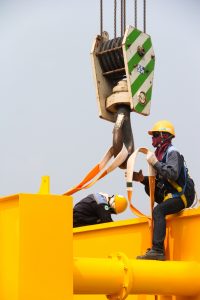What do painting, welding, insulating, and repairing have in common? They’re all duties performed in a shipyard, and they also all create respiratory hazards for workers. In conjunction with the shipbuilding industry’s previous use of asbestos in manufacturing, shipyards are hotbeds for respiratory diseases.
Today, we know the severe hazards of these materials, yet shipyard workers still face an excessive mortality rate. Asbestos is usually considered the main threat to shipyard workers — but it’s important to regulate other hazards as well. On June 19, OSHA released a new fact sheet pertaining to spray-paint hazards in shipyards. The sheet highlights the many necessary precautions that employers must take to safeguard workers.
Taking note from OSHA, we’ve broken down the lesser-known threats to workers in a shipyard including painting, welding & flame-cutting, and cleaning. Learn how employers can remain compliant and keep workers safe in the shipyard.
Spray Painting
Spray painting releases hazardous vapors into the air, which is especially dangerous when used in a confined space. Employers are responsible for communicating these hazards to their employees. OSHA notes states that, “where appropriate, employers must ensure chemical labels and safety data sheets are made available to exposed workers and train them on the hazards and measures necessary to protect themselves.”
OSHA requires a use of PPE (personal protective equipment) and engineering controls to regulate worker exposure. Engineering controls include tests that make sure the air quality stays below the PEL (permissible exposure limit), as well as exhaust ventilation that discharges contaminated air away from workers and ignition sources.
Welding & Flame-Cutting
Hazardous vapors can be released into the air during the welding or cutting of steel and aluminum materials. Workers face threats from heavy metal toxins such as cadmium, which causes both acute and chronic lung diseases. Just as with painting, the need for control and safety measures increases greatly when the work is done in an enclosed space.
Employers can remain compliant by using face masks and mechanical ventilation. OSHA requires ventilation in spaces where the overhead height is less than 16 feet, or there is less than 10,000 feet between each welder.
Learn more OSHA regulations regarding shipyard welding.
Cleaning Agents
Again, this may not be the first hazard that comes to mind when considering shipyard health and safety — yet, cleaning agents can put powerful chemicals in the air such as diesel and trichloroethane. These vapors can lead to oxygen-deficient atmospheres, which may be fatal.
Employers must make sure that all cleaning materials are clearly marked with their hazards. Proper PPE should be selected based on the materials used and how hazardous they are. Sometimes, airline respirators may even be necessary.
Proper ventilation should be used in order to maintain air levels below the PEL.
Learn more OSHA regulations regarding shipyard cleaning.
Medical Surveillance
Compliance doesn’t have to be complex. Employers can stay on top of the medical compliance and safety of workers in the shipyard with medical surveillance testing. Mobile medical companies such as Worksite Medical can perform respirator fit testing and respiratory screening right at the shipyard to make sure your employees haven’t been exposed to harmful chemicals or particles.
These comprehensive services can take some of the burden off employers and save productivity time by coming right to the worksite.




